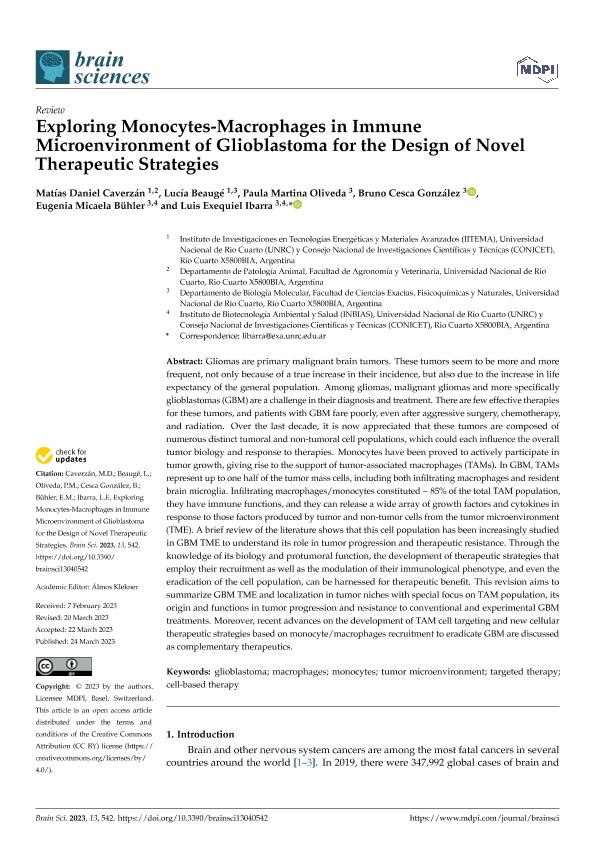Mostrar el registro sencillo del ítem
dc.contributor.author
Caverzan, Matias Daniel

dc.contributor.author
Beaugé, Lucía

dc.contributor.author
Oliveda, Paula Martina

dc.contributor.author
Cesca González, Bruno Agustín

dc.contributor.author
Bühler, Eugenia Micaela

dc.contributor.author
Ibarra, Luis Exequiel

dc.date.available
2024-03-11T12:22:53Z
dc.date.issued
2023-03
dc.identifier.citation
Caverzan, Matias Daniel; Beaugé, Lucía; Oliveda, Paula Martina; Cesca González, Bruno Agustín; Bühler, Eugenia Micaela; et al.; Exploring Monocytes-Macrophages in Immune Microenvironment of Glioblastoma for the Design of Novel Therapeutic Strategies; Multidisciplinary Digital Publishing Institute; Brain Sciences; 13; 4; 3-2023; 542-542
dc.identifier.issn
2076-3425
dc.identifier.uri
http://hdl.handle.net/11336/229990
dc.description.abstract
Gliomas are primary malignant brain tumors. These tumors seem to be more and more fre-quent, not only because of a true increase in their incidence, but also due to the increase in life expectancy of the general population. Among gliomas, malignant gliomas and more specifically glioblastomas (GBM) are a challenge in their diagnosis and treatment. There are few effective therapies for these tumors, and patients with GBM fare poorly, even after aggressive surgery, chemotherapy, and radiation. Over the last decade, it is now appreciated that these tumors are composed of numerous distinct tumoral and non-tumoral cell populations, which could each in-fluence the overall tumor biology and response to therapies. Monocytes have been proved to ac-tively participate in tumor growth, giving rise to the support of tumor-associated macrophages (TAMs). In GBM, TAMs represent up to one half of the tumor mass cells, including both infiltrat-ing macrophages and resident brain microglia. Infiltrating macrophages/monocytes constituted ~ 85% of the total TAM population, they have immune functions, and they can release a wide ar-ray of growth factors and cytokines in response to those factors produced by tumor and non-tumor cells from the tumor microenvironment (TME). A brief review of the literature shows that this cell population has been increasingly studied in GBM TME to understand its role in tumor progression and therapeutic resistance. Through the knowledge of its biology and protumoral function, the development of therapeutic strategies that employ their recruitment as well as the modulation of their immunological phenotype, and even the eradication of the cell population, can be harnessed for therapeutic benefit. This revision aims to summarize GBM TME and locali-zation in tumor niches with special focus on TAM population, its origin and functions in tumor progression and resistance to conventional and experimental GBM treatments. Moreover, recent advances on the development of TAM cell targeting and new cellular therapeutic strategies based on monocyte/macrophages recruitment to eradicate GBM are discussed as complementary therapeutics.
dc.format
application/pdf
dc.language.iso
eng
dc.publisher
Multidisciplinary Digital Publishing Institute
dc.rights
info:eu-repo/semantics/openAccess
dc.rights.uri
https://creativecommons.org/licenses/by/2.5/ar/
dc.subject
GLIOBLASTOMA
dc.subject
MACROPHAGES
dc.subject
MONOCYTES
dc.subject
TUMOR MICROENVIRONMENT
dc.subject
TARGETED THERAPY
dc.subject.classification
Otras Ciencias Médicas

dc.subject.classification
Otras Ciencias Médicas

dc.subject.classification
CIENCIAS MÉDICAS Y DE LA SALUD

dc.title
Exploring Monocytes-Macrophages in Immune Microenvironment of Glioblastoma for the Design of Novel Therapeutic Strategies
dc.type
info:eu-repo/semantics/article
dc.type
info:ar-repo/semantics/artículo
dc.type
info:eu-repo/semantics/publishedVersion
dc.date.updated
2024-03-08T14:36:54Z
dc.journal.volume
13
dc.journal.number
4
dc.journal.pagination
542-542
dc.journal.pais
Suiza

dc.journal.ciudad
Basilea
dc.description.fil
Fil: Caverzan, Matias Daniel. Universidad Nacional de Río Cuarto. Facultad de Ciencias Exactas Fisicoquímicas y Naturales. Instituto de Investigaciones en Tecnologías Energéticas y Materiales Avanzados. - Consejo Nacional de Investigaciones Científicas y Técnicas. Centro Científico Tecnológico Conicet - Córdoba. Instituto de Investigaciones en Tecnologías Energéticas y Materiales Avanzados; Argentina. Universidad Nacional de Río Cuarto. Facultad de Agronomía y Veterinaria. Departamento de Patología Animal; Argentina
dc.description.fil
Fil: Beaugé, Lucía. Universidad Nacional de Río Cuarto. Facultad de Ciencias Exactas Fisicoquímicas y Naturales. Instituto de Investigaciones en Tecnologías Energéticas y Materiales Avanzados. - Consejo Nacional de Investigaciones Científicas y Técnicas. Centro Científico Tecnológico Conicet - Córdoba. Instituto de Investigaciones en Tecnologías Energéticas y Materiales Avanzados; Argentina. Universidad Nacional de Río Cuarto. Facultad de Ciencias Exactas Fisicoquímicas y Naturales. Departamento de Biología Molecular; Argentina
dc.description.fil
Fil: Oliveda, Paula Martina. Universidad Nacional de Río Cuarto. Facultad de Ciencias Exactas Fisicoquímicas y Naturales. Departamento de Biología Molecular; Argentina
dc.description.fil
Fil: Cesca González, Bruno Agustín. Universidad Nacional de Río Cuarto. Facultad de Ciencias Exactas Fisicoquímicas y Naturales. Departamento de Biología Molecular; Argentina
dc.description.fil
Fil: Bühler, Eugenia Micaela. Universidad Nacional de Río Cuarto. Facultad de Ciencias Exactas Fisicoquímicas y Naturales. Departamento de Biología Molecular; Argentina. Universidad Nacional de Río Cuarto. Facultad de Ciencias Exactas Fisicoquímicas y Naturales. Instituto de Biotecnología Ambiental y Salud - Consejo Nacional de Investigaciones Científicas y Técnicas. Centro Científico Tecnológico Conicet - Córdoba. Instituto de Biotecnología Ambiental y Salud; Argentina
dc.description.fil
Fil: Ibarra, Luis Exequiel. Universidad Nacional de Río Cuarto. Facultad de Ciencias Exactas Fisicoquímicas y Naturales. Instituto de Biotecnología Ambiental y Salud - Consejo Nacional de Investigaciones Científicas y Técnicas. Centro Científico Tecnológico Conicet - Córdoba. Instituto de Biotecnología Ambiental y Salud; Argentina. Universidad Nacional de Río Cuarto. Facultad de Ciencias Exactas Fisicoquímicas y Naturales. Departamento de Biología Molecular; Argentina
dc.journal.title
Brain Sciences
dc.relation.alternativeid
info:eu-repo/semantics/altIdentifier/url/https://www.mdpi.com/2076-3425/13/4/542
dc.relation.alternativeid
info:eu-repo/semantics/altIdentifier/doi/http://dx.doi.org/10.3390/brainsci13040542
Archivos asociados
